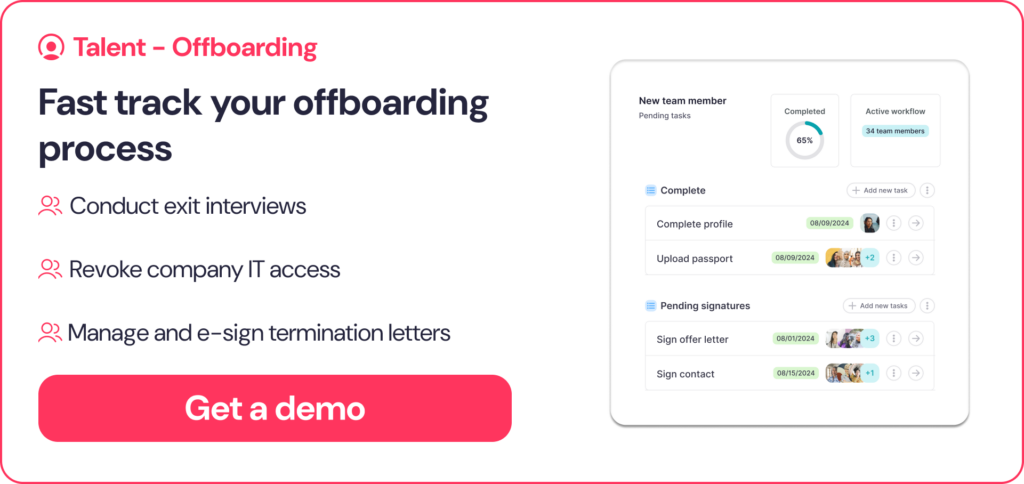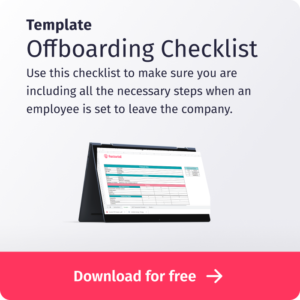In the state of Wisconsin, the Worker Adjustment and Retraining Act (WARN Act) protects workers during mass layoffs or plant closures. Congress passed the Act in 1988 to protect employees and give them enough time to find other employment or receive retraining before losing their jobs. HR managers need to know how the WARN Act works: what responsibilities employers have towards their workforce, how to ensure compliance with the Act, and how to issue a WARN notice in WI.
- Does Wisconsin have WARN Act?
- What is the WARN Act Wisconsin?
- Wisconsin WARN notices
- What triggers the WARN Act in Wisconsin?
- Wisconsin WARN Act requirements
- How is the WARN Act enforced in Wisconsin?
- Understanding the WARN Act is crucial
- Plant closure/Offboarding Best practices
- Offboard your employees with HR software 🚀

Does Wisconsin have WARN Act?
Wisconsin doesn’t have a seperate, state-level WARN Act, also called a mini-WARN Act. In Wisconsin, the federal WARN Act applies to protect workers during changes in the workforce, such as mass layoffs and plant closures.
How the federal WARN Act works in Wisconsin
Although there is no individual WARN Act passed by the government of Wisconsin, workers are not left without any protection. The federal WARN Act still applies in the state. Employers in Wisconsin must provide employees with WARN Act notifications prior to the office, plant, or branch closing where those workers are employed. A WARN notice must contain all the details necessary for the employee to understand the situation, including the number of workers affected by the layoff, as well as who they contact for more information. The notice letter must be in writing.
Wisconsin doesn’t have mini-WARN
Unlike Wisconsin, some states have passed their own individual WARN Acts, called mini-WARN Acts. These function very similarly to the federal WARN Act, but often have some differences regarding the number of employees laid off that trigger the WARN Act, and the standard procedure by which employers must handle these situations. Sometimes the penalty is different as well in states that have a mini-WARN.
For a list of states that have their own mini-WARN Act, check out our article on the federal WARN Act. We also have articles on the federal and state holidays celebrated in each state, with a separate article on Wisconsin holidays. If you are looking for information on Wisconsin minimum wage, we’ve also got you covered.
Wisconsin WARN Act explained
The WARN Act ensures that employees in Wisconsin are protected during mass layoffs and when plants or offices are being closed. Before employers make the decision to lay off workers or close one of their locations for good, they are required by the WARN Act to send advance notification to all employees affected by the decision. This requirement gives employees enough time to find another job. With many companies laying off employees last year, HR managers need to understand how mass layoffs need to be conducted in a way that follows all legal requirements.
HR managers have a lot on their plate all throughout the year. Knowing the dates for filing important documents can help. Use our HR compliance calendar to stay on top of your HR paperwork:
WARN Notices in Wisconsin
The WARN Act states that employers have to give Wisconsin employees 60 days notice when initiating a mass layoff. If any of those employees belong to a union, then the union representatives have to be notified instead of the individual employees.
There isn’t a standard template that has to be used for the WARN notice letter, but it has to be documented and include all essential details about the situation.
What to include in a WARN notice?
A WARN notice letter must include details such as the location of the mass layoff or plant closure, the reason the mass layoff or plant closure is taking place, whether this loss of employment is temporary or permanent, the job titles that are affected, the number of affected employees, any union affiliations, and contact information for inquiries.
You can check out recent examples of WARN notices in Wisconsin here.
Who needs to receive a WARN notice?
Employers covered by the WARN Act in Wisconsin need to send a notice letter containing all of the details mentioned above to impacted employees, their labor union representatives, the state Rapid Response Team, and the primary elected official of the local government where the workplace is. The WARN notice letter has to be sent 60 days in advance of the mass layoff or plant closure.
Wisconsin WARN Act Triggers
The WARN Act is triggered by certain events like mass layoffs and plant closures, but there are more specific reasons detailed as well.
These conditions trigger the WARN Act:
- A plant closure that affects 50 employees within a minimum of 30 days.
- A mass layoff that involves a minimum of 500 full-time employees.
- A mass layoff that impacts at least 50 full-time employees if those 50 employees constitue 33% of the employer’s workforce.
- Mass layoffs or plant closures that last over 90 days.
What is a plant closure?
A plant closure is defined as 50 or more full-time employees losing their jobs as a result of a worksite or facility closing.
What is a mass layoff?
A mass layoff is when 500 or more full-time employees lose their jobs within a 30 day period. This doesn’t necessarily have to involve the closing of a plant. It also applies when 50-499 employees lose their jobs if the number of employees make up 33% of the employer’s workforce.
What are extended layoffs?
When the number of layoffs reach the threshold of triggering the WARN Act cumulatively, within a 90 day period. For example, multiple groups of workers lose their jobs and individually they do not trigger the WARN Act and do not require advance notification, but together, they reach the threshold.
Wisconsin WARN Act Requirements
The WARN Act applies to Wisconsin employers with more than 100 employees. This excludes employees with less than 6 months of service at the company in the past 12 months and the employees who work less than 20 hours a week on average.
The Act applies to all types of employers: private, for-profit employers, and private, nonprofit employers, as well as public employers. Both hourly and salaried employees have to be notified in advance about mass layoffs and plant closures, as well as managerial and supervisory staff. Business partners do not need to be notified under the WARN Act.
The main purpose of the WARN Act is to protect employees and give them enough time to find a new place of employment. The most important aspect of the act is advance notification.
Wisconsin encourages all employers to provide employees with prior notice, even if they do not meet the trigger threshold laid out in the Act.
How is the WARN Act enforced in Wisconsin?
The WARN Act is enforced in Wisconsin by the United States District Courts. Workers, as well as their representatives and local government entities can initiate individual or class-action lawsuits against employers who violate the the WARN Act. A violation can mean that the employer failed to issue a WARN notice letter to all employees affected by the layoffs. Penalties can include being mandated to give back pay to affected workers or penalties of $500 per day for each day of violation. Employers have to settle these issues with employees within three weeks of the layoffs.
We encourage employers to seek legal guidance and consultation from Wisconsin attorneys and to always refer to official sources for the most up-to-date information on WARN Act requirements, as the law is subject to change.
Understanding the WARN Act is important
Wisconsin HR managers and employers need to understand the WARN Act, especially if the company is covered by the WARN Act. Non-compliance with the law can have severe consequences for the company financially. With a thorough understanding of the Act, employers have the opportunity to handle layoffs and plant closures in a way that is strategic and compliant with the law. It also helps build and foster trust with employees and keep a good reputation.
How can HR software help with all of this?
Laying off employees is never easy. It takes a lot of work, resources, and care to do them right. HR managers have to balance a dozen responsibilities to make sure employees rights are respected and all processes are on track. This is where HR software can help you. With HR software like Factorial, you can manage employee access, request and collect employee documentation, request e-signatures, and more!
Human resources software can also help you manage everyday tasks like tracking employee time off, hours spent on various projects, when workers clock in and out, as well as what skills need to be developed and how. Factorial is a platform that helps you centralize all of these process in a single centralized hub.
Chat with a product specialist to learn how Factorial can help your business. Click on the banner below to book a free demo call and see a personalized version of our software tailored to your company’s needs to see exactly how Factorial would fit your needs and make your job much easier. Automate manual HR tasks so you can focus on more strategic tasks with Factorial!




